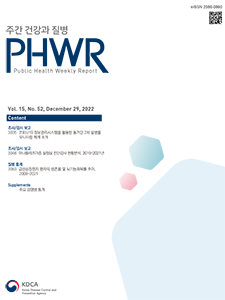Current Issue
Vol.15 No.52, December 29, 2022
-
Surveillance Reports 2022-12-29
 0
0
 1874
1874
 393
393
Introduction of the Secondary Attack Rate Monitoring System for Household Contacts Using the COVID-19 Information Management System
Mi Jeong Ko, Do Sang Lim, Young-Man Kim, Ji Hyeon Lim, So Yeon Park, Young-Joon Park
Public Health Weekly Report 2022; 15(52): 3035-3045 https://doi.org/10.56786/PHWR.2022.15.52.3035 Abstract
AbstractThe Korea Disease Control and Prevention Agency (KDCA) operates the coronavirus disease 2019 (COVID-19) information management system and uses it to respond to COVID-19. As the number of confirmed COVID-19 cases surged after the introduction of the Omicron variant into the Republic of Korea, it became necessary to change the quarantine response strategy. For a rapid and efficient epidemiological investigation, the confirmed case report form (the mobile-based and selfreported) was introduced, which simplified survey questions. Since then, the COVID-19 case reporting form database (Cov-CRF-DB) has been created using data from the COVID-19 information management system. In order to timeously utilize the Cov-CRF-DB, the secondary attack rates (SAR) monitoring system for household contacts was updated with monitoring indicators. The number of confirmed cases over the last four weeks (September 4–October 1, 2022) was 1,250,651, of which 676,814 were household contacts. The number of index patients with the earliest confirmation date in the household was 249,318, and the number of confirmed household contacts of those index patients was 653,628, with a 28.4% SAR. In future, confirmed patients and their household contacts will be monitored to prevent secondary infection and the information will be shared with the relevant institutions. If required, sub-groups will be further researched.
-
Surveillance Reports 2022-12-29
 0
0
 1244
1244
 376
376
Analysis of the Status of Anaplasmosis Laboratory Diagnosis, 2019–2021
Miyeon Kim, Byoungchul Gill*, Junyoung Kim, Jaeil Yoo
Public Health Weekly Report 2022; 15(52): 3046-3062 https://doi.org/10.56786/PHWR.2022.15.52.3046 Abstract
AbstractAnaplasmosis is a tick-borne zoonotic disease, the causative agent of which is Anaplasma phagocytophilum. This study analyzed the positivity rate, sex, age, clinical findings, and time period of domestic anaplasmosis infection based on the results of confirmed diagnosis of anaplasmosis commissioned by the Korea Disease Control and Prevention Agency from 2019 to 2021. In the past three years, a total of 2,024 samples have been referred for suspected anaplasmosis infection, and the number of patients who were finally confirmed positive were 3.4% (31 people) in 2019, 5.6% (31 people) in 2020, and 8.7% (48 people) in 2021. 64.5% (71 female) and 71% (78 people) were identified in the age group over 70 years of age. Clinical findings in patients confirmed to be anaplasmosis positive were based on fever (84%) symptoms, but the highest positivity rate was seen in patients (41.3%) who had both fever and decreased platelet counts. The Seoul area had the largest number of requests for domestic anaplasmosis samples, but the Jeonbuk region showed the highest distribution of anaplasmosis patients with a positivity rate of 25.5%, and it was confirmed that they were concentrated from May to July. Anaplasmosis patients have confirmed a high positivity rate in samples that fully consider the patient's clinical findings such as fever, decreased platelet count, outdoor activity, and tick bite. This study expected to be used as basic data for surveillance, spread, and management of zoonotic diseases.
-
QuickStats 2022-12-29
 1
1
 466
466
 105
105
Trends of Survival and Brain Function Recovery in Sudden Cardiac Arrest Patients, 2008–2021
Public Health Weekly Report 2022; 15(52): 3063-3064 https://doi.org/10.56786/PHWR.2022.15.52.3063

pp. 1433~1461
Most Keyword
?
What is Most Keyword?
- It is the most frequently used keyword in articles in this journal for the past two years.
Most Read
-
Waterborne and Foodborne Disease Outbreaks in the Republic of Korea, 2023
Myung-Jae Hwang, So Yeon Park, Hyungjun Kim, Se Jeong Yang, Sungchan Yang, Jin Seon Yang
Public Health Weekly Report 2025;18: 17-32 https://doi.org/10.56786/PHWR.2025.18.1.2 -
Implementation Plan for the Coronavirus Disease 2019 Vaccination for the 2024–2025 Season: Recommendations of the 6th Expert Committee on Immunization Practices
Hyewook Hwang, Wookeon Lee, Seohyeon Ahn, Young-Sook Choi, Seunghyun Lewis Kwon, Dongwoo Lee, Eun Hwa Choi, SokGoo Lee
Public Health Weekly Report 2025;18: 90-102 https://doi.org/10.56786/PHWR.2025.18.2.3
Editorial Office
+82-43-719-7569





 Full Text
Full Text Cite
Cite


